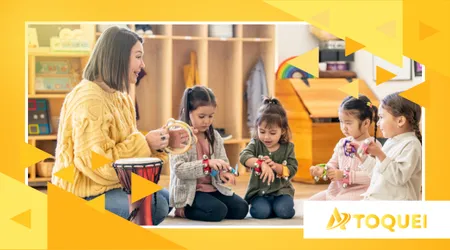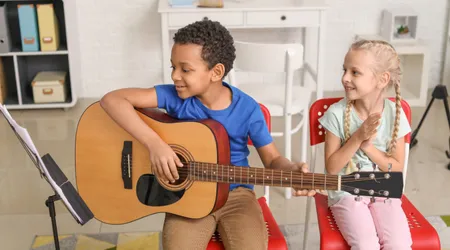How to set up a music corner for young children

Setting up a music corner for young children It is an investment in sensory and cognitive development that bears fruit for life.
Advertisements
Music, after all, is the first universal language that a child assimilates, long before words.
Transforming a small space into a sound studio for little ones is a pleasurable journey. It's not about creating future musicians, but rather about enriching children's experiences with rhythms and melodies.
Early interaction with the world of sounds stimulates fine and gross motor coordination. The simple act of beating a drum or shaking a rattle is a complete learning experience.
This musical refuge needs to be safe, accessible, and, above all, inspiring natural curiosity. Think of this space as a playful stage for spontaneous expression.
Advertisements
Let's explore, with a practical and insightful approach, how to bring this vibrant environment to life.
The Purpose of Space: More than a Toy, a Tool
Many parents focus on electronic toys, but the value of a real instrument, even a child-friendly one, is irreplaceable. A tangible instrument teaches cause and effect immediately and concretely.
The authentic sound of a wooden xylophone, for example, is infinitely superior. It develops auditory acuity, differentiating timbres and sound textures.
Music acts as a bridge to learning other areas of knowledge. It improves memory and concentration for complex tasks.
Furthermore, singing and rhythmic exploration are powerful allies in language development. Children expand their vocabulary and improve their communication skills.
This corner will be the laboratory where children will make their first important harmonic discoveries. The purpose is to nurture a passion for creation.
Read more: Difference between electronic and acoustic drums: which is more worthwhile?
Strategic Instrument Selection: What to Prioritize
The key to success lies in the curation of instruments. Choose durable items that offer different types of sound interaction.
Avoid toy overload; less is more when it comes to musical quality. The focus should be on the in-depth exploration of a few elements.
Prioritize percussion instruments, as they are the most intuitive for preschoolers. Tambourines, maracas, and wooden blocks are all good choices.
Also include a simple melody instrument, such as a small keyboard or a xylophone with colored keys. This introduces the concept of notes and scales.
Don't forget about "instruments" made from everyday objects, as they stimulate creativity. Pot lids can be turned into fun drum cymbals.
One original example is to transform empty yogurt pots, coated and decorated, into small drums with different sounds, depending on the filling.

Ergonomics and Safety: The Design of the Corner
The space should be easily accessible, preferably at ground level and in a well-lit area. Visual organization is crucial.
Use low shelves and open baskets, allowing children to pick up and put away instruments independently. Independence is a cornerstone of this learning process.
++ Children's songs in other languages
Safety is non-negotiable. Make sure all instruments are non-toxic and have no small parts that could be swallowed.
For acoustic comfort, you can add a thick rug or a simple fabric panel to the nearby wall. This will muffle the sound and make it more pleasant.
Setting up a music corner for young children It also means creating a welcoming and visually stimulating environment. Vibrant colors encourage lingering.
The Importance of Sound Curation in the Digital Age
We live in the age of streaming, but quality music and silence are also important. Don't underestimate the power of active, focused listening.
++ Musical games to teach rhythm to children at home
The American Academy of Pediatrics (AAP), for example, highlights that direct musical interaction, such as singing to a child, is more beneficial than passive exposure to audio.
One original example One way to encourage this is to create a “Young Composer’s Day”, where the child can record (even with a cell phone) the “song” they have just invented in the corner.
This transforms play into a creative project and boosts children's self-esteem. They feel valued as creators of art.
A pertinent analogy: if a child's brain is a garden, music is the rain that nourishes it. Without it, the growth of the flowers of thought is slower and less colorful.
Creating the Musical Routine: Interaction and Inspiration
It's not enough just set up a music corner for young children, it's essential to encourage them to use it frequently and freely. Routine fosters habit.
++ Children's musical development
Set aside a moment of the day, free from obligations, for uncommitted musical exploration. The adult's role is that of observer and occasional partner.
Adults shouldn't dictate how children play; chaotic experimentation is an integral part of the early creative process. Let children be the conductor of their own orchestra.
A relevant fact from 2024 National Association for Music Education (NAfME) in the United States points out that children regularly exposed to music education present up to 20% improvement in reading and mathematical reasoning skills.
This reinforces the thesis of integral development.
The freedom for sonic invention is what truly makes the magic happen in this space. The child is, in effect, inventing their own rhythmic grammar.
Essential Instrument Chart for Beginners
| Category | Suggested Instrument | Skill Developed |
| Simple Percussion | Rattle eggs or maracas | Fine motor coordination, rhythm |
| Drum Percussion | Small drum or bongo | Gross motor coordination, pulse |
| Basic Melody | 8-note xylophone | Hearing acuity, introduction to scales |
| Accessories | Colorful scarves (for dancing) | Body expression, movement |
The Legacy of Sound
Creating an environment for music is an act of care and intelligence. You're providing the child with tools to understand the world.
After all, why limit a child to spoken language when he or she can have the richness of musical language at his or her disposal?
Invest in this space with the certainty that you are sowing joy, intelligence, and sensitivity. The best time to set up a music corner for young children and now.
This little corner will become one of the pillars of your fond childhood memories.
Frequently Asked Questions
What is the ideal age to start using the music corner?
There's no minimum age. Babies already respond to sounds and rhythms. From the moment a child can hold a rattle securely, they can begin exploring space.
Do I need to be a musician to help my child?
Absolutely not. Adult participation should be encouraging and playful. Singing simple songs and dancing together is already a rich and sufficient musical interaction.
Can I use real instruments or just toys?
The ideal is a mix. Real instruments (like a simple adult tambourine) offer richer tones and greater durability, but should be supervised. Age-specific toys ensure greater safety.
Where should I position the corner inside the house?
Choose a spot that's out of the way and where noise won't disrupt your daily routine. A corner of a bedroom or playroom is ideal, as long as it's a fixed area.
